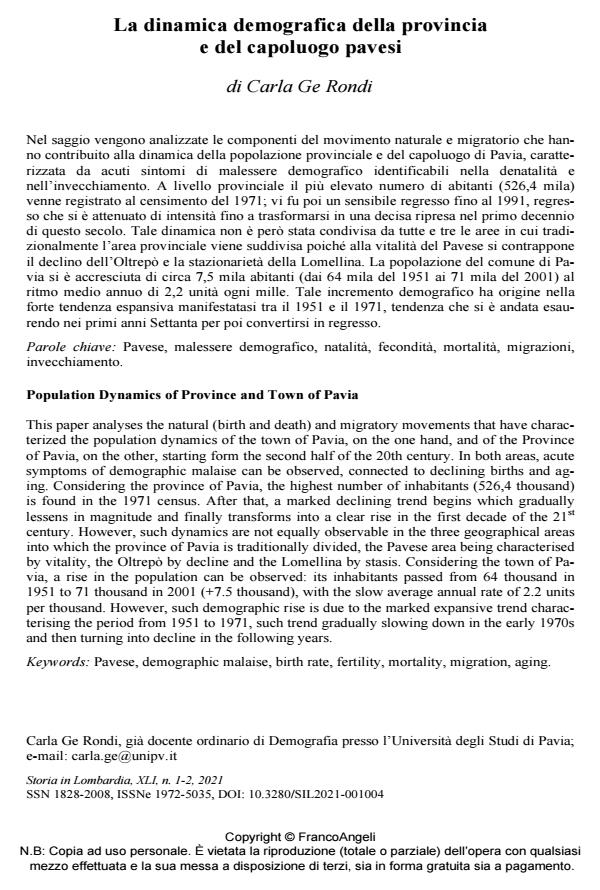Population Dynamics of Province and Town of Pavia
Journal title STORIA IN LOMBARDIA
Author/s Carla Ge Rondi
Publishing Year 2022 Issue 2021/1-2 Language Italian
Pages 16 P. 57-72 File size 137 KB
DOI 10.3280/SIL2021-001004
DOI is like a bar code for intellectual property: to have more infomation
click here
Below, you can see the article first page
If you want to buy this article in PDF format, you can do it, following the instructions to buy download credits

FrancoAngeli is member of Publishers International Linking Association, Inc (PILA), a not-for-profit association which run the CrossRef service enabling links to and from online scholarly content.
This paper analyses the natural (birth and death) and migratory movements that have characterized the population dynamics of the town of Pavia, on the one hand, and of the Province of Pavia, on the other, starting form the second half of the 20th century. In both areas, acute symptoms of demographic malaise can be observed, connected to declining births and aging. Considering the province of Pavia, the highest number of inhabitants (526,4 thousand) is found in the 1971 census. After that, a marked declining trend begins which gradually lessens in magnitude and finally transforms into a clear rise in the first decade of the 21st century. However, such dynamics are not equally observable in the three geographical areas into which the province of Pavia is traditionally divided, the Pavese area being characterised by vitality, the Oltrepò by decline and the Lomellina by stasis. Considering the town of Pavia, a rise in the population can be observed: its inhabitants passed from 64 thousand in 1951 to 71 thousand in 2001 (+7.5 thousand), with the slow average annual rate of 2.2 units per thousand. However, such demographic rise is due to the marked expansive trend characterising the period from 1951 to 1971, such trend gradually slowing down in the early 1970s and then turning into decline in the following years.
Keywords: Pavese, demographic malaise, birth rate, fertility, mortality, migration, aging.
- Caselli G. e Egidi V. (1980), Le differenze territoriali di mortalità in Italia. Tavole di mortalità provinciali (1971-72), Roma, Università di Roma La Sapienza, Facoltà di Scienze Statistiche Demografiche e Attuariali, Istituto di Demografia.
- Ge Rondi C. (1978), Caratteri della popolazione pavese rilevanti ai fini di una politica del commercio. Un’analisi per quartieri, in «Pavia Economica», giugno 1978, pp. 81-95.
- Ead. (1992), Tendenze evolutive ed assetto della popolazione del territorio pavese, in Distaso S., a cura di, La popolazione delle città italiane. Tendenze in atto e prospettive, Bari, Cacucci Editore, pp. 433-452.
- Ead. (2000), Les régions du triangle industriel en Italie: de la transition économique à la transition démographique, in AIDELF, a cura di, Régimes démographiques et territoires: les frontières en question, Paris, Presses Universitaires de France, pp. 293-304.
- Ead. (2006), I caratteri demografici della provincia di Pavia, in Centro Studi ALSPES, a cura di, Famiglia: problema o risorsa? Rapporto di ricerca sulla famiglia della provincia di Pavia, Pavia, Centro Servizi Formazione, pp. 194-198.
- Gerzeli S. (1993), Aree di malessere demografico in Lombardia: il caso della provincia di Pavia, in «Rivista milanese di economia», n. 48, pp. 103-118.
- Livi Bacci M. (1990), Introduzione alla demografia, Torino, Loescher
Carla Ge Rondi, La dinamica demografica della provincia e del capoluogo pavesi in "STORIA IN LOMBARDIA" 1-2/2021, pp 57-72, DOI: 10.3280/SIL2021-001004